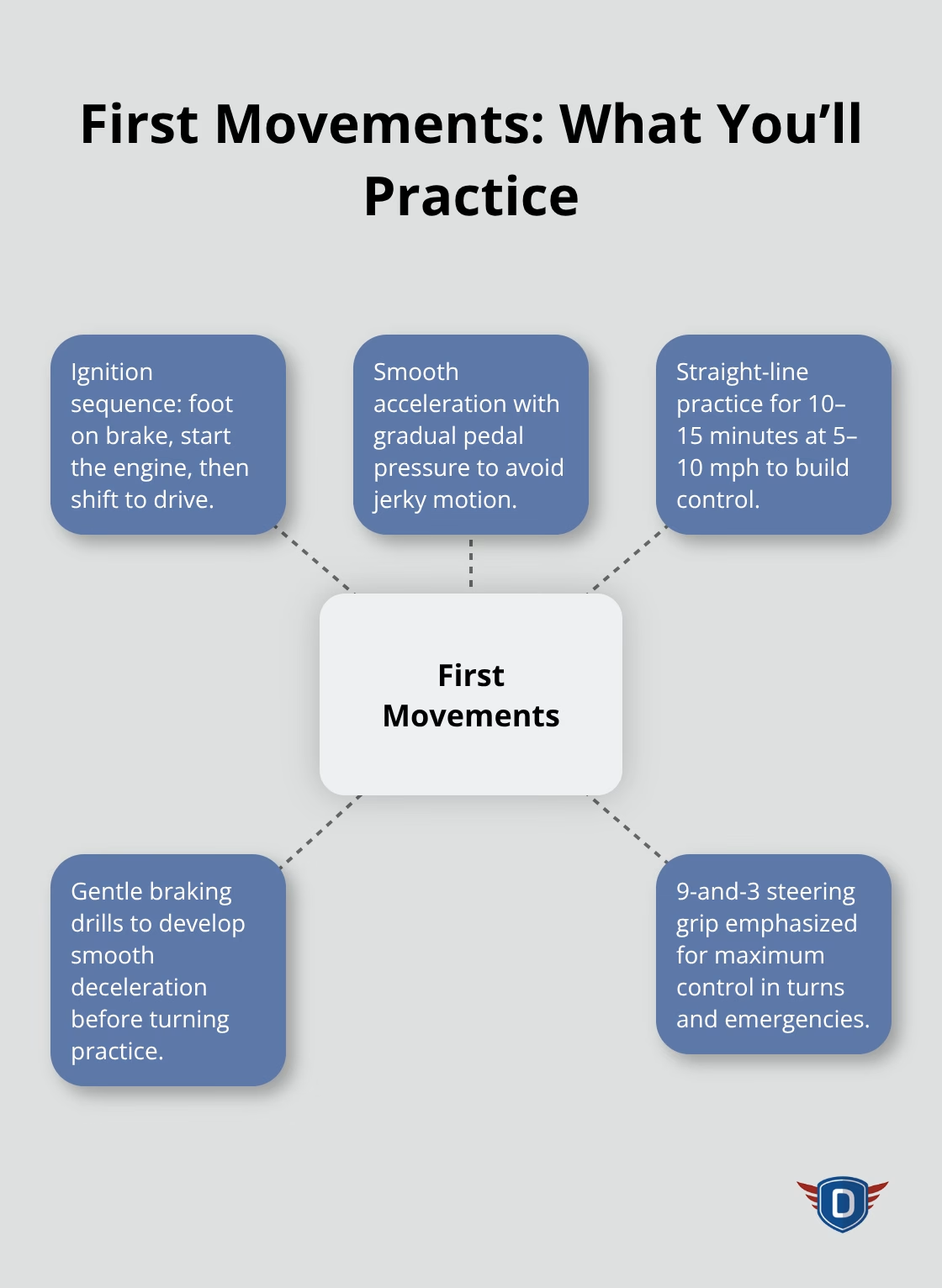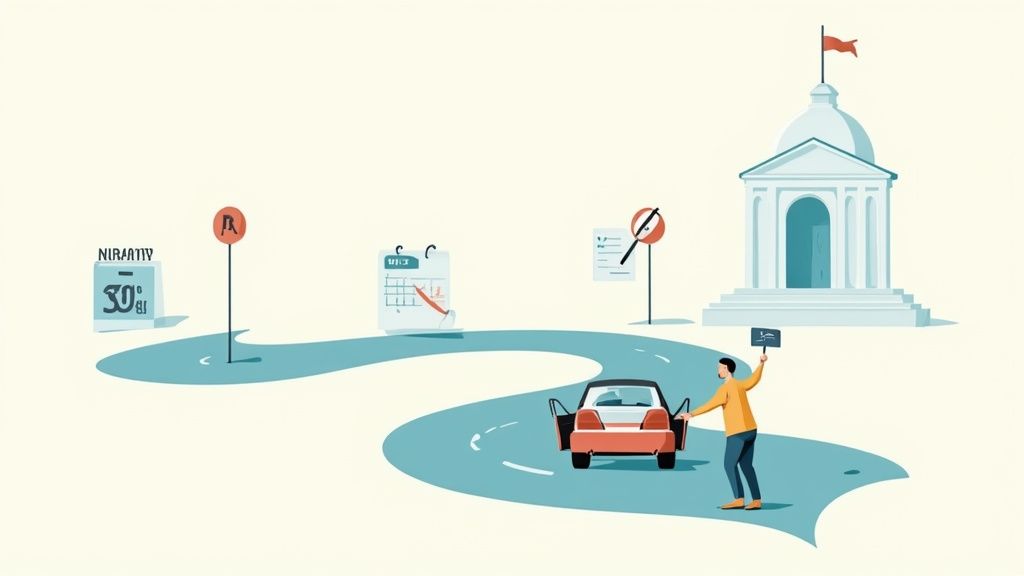Your first driving lesson marks the beginning of your journey toward independence on the road. Many new drivers feel nervous about what to expect on their first driving lesson, but understanding the process helps reduce anxiety.
We at DriverEducators.com know that preparation makes all the difference. Most first lessons focus on basic vehicle familiarization and simple parking lot maneuvers rather than busy streets.
What Happens Before You Start Driving
Required Documentation for Your First Lesson
Your driving instructor requires specific documents before you can legally begin your lesson. Most states mandate a valid learner’s permit, which involves passing a vision exam, taking a photo, and completing knowledge tests with multiple choice questions based on the state driver’s handbook. Texas law requires you to bring your learner’s license to every lesson, and instructors cannot proceed without proper documentation. Some schools also request parent or guardian signatures for students under 18, plus emergency contact information and medical condition disclosures that might affect your ability to drive.

Vehicle Safety Inspection and Control Overview
Professional instructors dedicate 15-20 minutes to vehicle inspection before you start driving. This process includes mirror checks, seat position adjustments, steering wheel alignment, and pedal accessibility verification. Your instructor will show you dashboard indicators, turn signals, windshield wipers, and emergency brake location. Most driving schools use dual-control vehicles with instructor brake pedals for safety purposes. Students who receive thorough vehicle orientation during their first lesson demonstrate better control during later sessions.
Initial Knowledge and Comfort Evaluation
Your instructor assesses your traffic rule knowledge and anxiety level through brief questions. This evaluation determines lesson pace and starting location. Students who score higher on basic traffic knowledge typically begin on quiet residential streets, while those who need more review start in empty parking lots. Instructors also measure your comfort level to adjust teaching methods, whether you learn better through verbal instruction or hands-on demonstration.
Once your instructor completes these preliminary steps, you’ll move to the most anticipated part of your lesson: actually getting behind the wheel and experiencing your first moments as a driver.
Your First Time Behind the Wheel
Proper Seat Position and Mirror Setup
Your instructor will guide you through precise seat adjustments before you touch any controls. Position your seat so your knee maintains a slight bend when you press pedals fully, and your wrists rest on top of the steering wheel when you extend your arms. Adjust your rearview mirror to frame the entire rear window and side mirrors to show a sliver of your vehicle’s side plus the adjacent lane. Most new drivers sit too close to the steering wheel, which reduces reaction time during emergencies. Professional instructors spend 5-7 minutes on proper position because incorrect setup causes control issues during first lessons according to National Highway Traffic Safety Administration data.
Engine Start and First Movements
Your instructor will demonstrate the ignition sequence: foot on brake, key turn or push-button start, then shift to drive. Practice smooth acceleration when you press the gas pedal gradually rather than make sudden movements that cause jerky motion. Most first lessons begin with 10-15 minutes of straight-line practice in empty parking lots at 5-10 mph speeds.

Common First-Lesson Challenges
Most new drivers struggle with brake sensitivity during their initial attempt, often they stop too abruptly or too gradually. Professional instructors address this when they have students practice stops at specific parking lot markers until they achieve smooth deceleration. Steering overcorrection affects many first-time drivers, which causes zigzag patterns instead of straight lines. Your instructor will teach you to make small steering adjustments and focus your vision ahead rather than directly in front of the hood. Nervous students benefit from deep breath exercises between practice sessions, and instructors often switch to passenger demonstration when anxiety peaks.
These fundamental skills form the foundation for more advanced techniques you’ll learn as your driving lessons progress.
What Skills You’ll Master in Early Lessons
Core Techniques and Traffic Rules
Your early lessons focus on fundamental techniques that form the foundation of safe driving. Professional instructors teach you to maintain consistent speeds, execute smooth lane changes, and perform proper turns at intersections. Most schools dedicate significant early lesson time to parking maneuvers, including parallel parking, three-point turns, and backing into spaces. Students who practice these skills in controlled environments show better performance on road tests.
Traffic rule instruction covers right-of-way scenarios, speed limit compliance, and proper signaling distances. Your instructor will teach you proper signaling techniques for various driving situations. These rules become second nature through consistent practice and immediate feedback from your instructor.
Progressive Skill Development
Instructors use structured progression methods that build skills systematically over multiple lessons. Week one typically covers parking lot basics, week two introduces residential streets, and week three advances to busier roads with traffic lights.

Your instructor adapts lesson difficulty based on your comfort level and skill demonstration. Nervous learners benefit from extra parking lot practice, while confident students advance to highway merging sooner. Most professional instructors use positive reinforcement techniques, celebrating small victories like smooth stops or successful parallel parks to build your confidence systematically.
Personalized Teaching Methods
Experienced instructors recognize that visual learners need demonstration, auditory learners respond to verbal instruction, and kinesthetic learners require hands-on practice. Visual learners benefit from diagram explanations of turning radius and blind spot locations, while auditory learners prefer step-by-step verbal guidance during maneuvers. Kinesthetic learners need repetitive practice with immediate feedback on steering pressure and pedal control.
Professional instructors adjust their communication style within the first two lessons based on how you respond to different instruction methods. Students matched with compatible teaching styles complete their training faster than those with mismatched instructor approaches.
Final Thoughts
Your first lesson establishes the foundation for safe, confident driving. Most students complete their initial session with a sense of accomplishment after they master basic vehicle controls and simple parking lot maneuvers. Professional instructors use structured approaches that reduce anxiety while they build essential skills systematically.
Proper preparation makes your first lesson more productive. Get adequate sleep the night before, wear comfortable shoes with good pedal grip, and arrive early to reduce stress. Bring your learner’s permit and any required documentation to avoid delays (mental preparation involves acceptance that mistakes are part of learning).
We at DriverEducators.com provide comprehensive driver education programs with certified instructors who create supportive environments. Our personalized guidance helps students master necessary skills while they develop lifelong safe habits. Understanding what to expect on your first driving lesson prepares you for success throughout your driver training journey.





